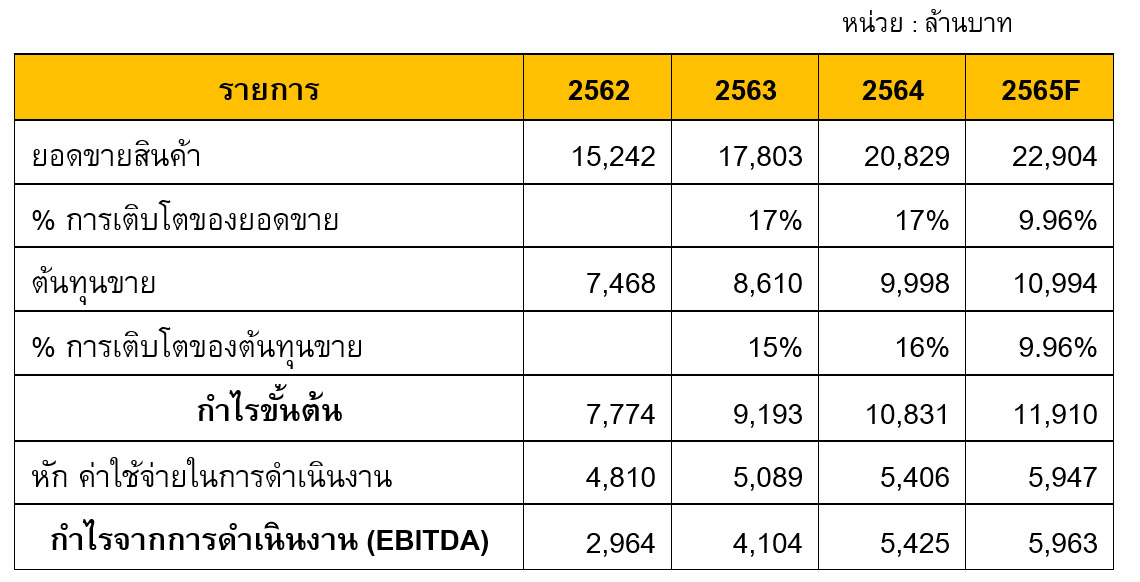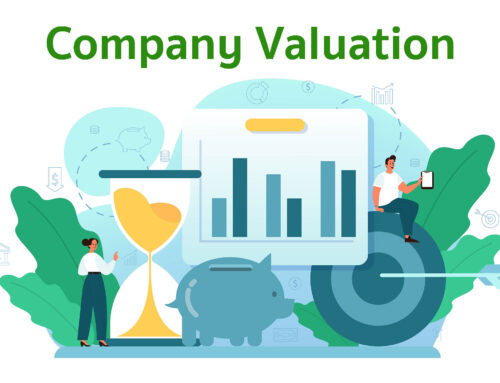The main objective of the listed company’s financial management is to create maximum wealth for shareholders, reflected in the company’s performance and value. Assumptions and factors affecting the value of the Company. Make investment decisions to ensure sustainable growth of the company’s performance and value. This article presents the process of preparing financial estimates and stock valuations consisting of 14 steps. as follows
For those who want to read specific topics, you can click here.
- 1. Preparing Past Financial Statement
- 2. Building up Assumptions
- 3. Forecast Sale Growth
- 4. Cost of goods sold estimate
- 5. Operating Expenses Budget
- 6. Preparation of budgeted statement of income
- 7. Capital Expenditures Budget
- 8. Cash estimates of the entity As
- 9. Estimating retained earnings
- 10. Analysis of the Statement of Financial Position
- 11. The Analysis of Cash Flow statements
- 12. Analysis of financial ratios This procedure summarizes
- 13. Discount cash flow valuation
- 14. Relative Valuation is a valuation
- Financial Projection Assistance
1. Preparing Past Financial Statement
The financial statements are a reflection of the company’s operating results. Therefore, in anticipating the future performance of the business, It relies on information from the Company’s historical financial statements, which include: Statement of Financial Position Comprehensive Income Statement Cash flow statements and financial ratios to be used to analyze past performance and to determine future growth prospects. These are public information that can be obtained from the Company’s Annual Report or Form 56-1 report that the listed company must disclose to stakeholders.
2. Building up Assumptions
After compiling the historical financial statements of the entity. The next step is to determine the growth assumptions of key factors in the financial statements that affect changes in the company’s cash flows and financial position in the future, starting with determining the rate of future sales growth. It may be defined as sales growth relative to the rate of economic growth (GDP), as well as the cost of selling goods. Revenues and operating expenses, investment budgets, respectively.
3. Forecast Sale Growth
Sales are considered an important variable in financial estimates because the value of goods and services that the business will sell in the future is correlated with raw material costs, inventories levels, etc. These factors directly affect the Company’s profitability, including future financing and investment plans. In general, there are two ways to estimate sales:
- The Bottom Up Method is a forecasting method that relies on the opinions of management or salespeople who are considered experienced and close to the operation of the business, who predict future sales and use the information obtained to consider the potential and future investment plans of the business.
- Top-Down Method This method analyzes the relationship between historical sales growth rates and the rate of change in the industry growth average or economic growth rate. (GDP) is expressed as follows:
- An example of the regression analysis based on historical data from the past 10 years, which defines GDP growth as an independent variable and sales growth as a dependent variable, considering the R Square value of 0.971, shows that the two variables are significantly correlated, and from the regression coefficient, it can be predicted that if gdp growth in 2022F grows at the level of 5.00%, the sales of the business in 2022F will grow to 9.96%, as follows:
This is to ensure that sales estimates are accurate and consistent with the company’s ability to grow. Analysts should consider both the Top-Down method and the Bottom Up Method.
4. Cost of goods sold estimate
Cost of sales refers to the cost of producing goods and expenses that make the goods in a state of readiness, such as raw materials, transportation costs, etc. That is to say, if the business wants to increase sales higher. The cost of sales will also increase as a result. It is usually possible to use the figures of sales growth each year to estimate the cost of sales that will increase. For example, from Step 1, we estimate that the sales growth rate in 2022F will increase from 2022 to 9.96%, so the analyst can estimate that the cost of sales in 2022F will increase at the same rate as in Table 2.1. Once deducted from the cost of sales, how much gross profit will be left to analyze the company’s ability to earn income and control costs?
5. Operating Expenses Budget
In addition to the cost of sales, the business also has another part of the cost, namely operating expenses, which consists of: Expenses, salaries, employees Advertising and public relations fees All of the above items have an impact on the profitability of the business. Therefore, in estimating the costs, it must be consistent with future expansion plans. For example, in 2022F, management predicts that the business will expand well, so they want to increase the number of employees and salary rate from 10 percent. When operating expenses are deducted from gross profit, we will receive profit before interest, income tax, and depreciation or EBITDA, as shown in Table 2.1.
6. Preparation of budgeted statement of income
This procedure is a compilation of items that have made financial estimates and records them in the comprehensive income statement. To analyze the company’s performance in each year, there are two classification principles of accounting: a single-tier income statement, a separate record showing income and expenses, and then deducting all income from total expenses to be represented as net profit or loss. This method is simple, but the disadvantage is that profitability analysis is done only by looking at the net profit. It is not possible to see the profitability of other aspects of the entity, a multi-tiered income statement, a record of sales revenues deducted by each type of expense in a hierarchical manner. This makes it more useful because users of financial statements can evaluate the operating results over the period based on profit at each stage, including gross profit, operating profit, profit before interest, income tax and depreciation.

Table 2.1 Sample cost of sales estimates Operating expenses and comprehensive income statements
The above profit is only operating profit. In order to find the net profit that is in the last line of the comprehensive income statement, other items such as depreciation and interest paid must be included.

7. Capital Expenditures Budget
also known as CAPEX, refers to the cost of investing in the acquisition of assets for use in the Company’s operations, which are divided into 3 parts: the cost of acquiring new assets (New Investment CAPEX), such as the purchase of land, buildings, new machinery to support production volumes and future expansion of the business. The second part is the cost of maintaining the old asset in working condition. (Maintenance CAPEX), such as factory repairs and renovations. machine The last part, Replacement CAPEX, is the cost of buying a new asset to replace an old asset that has a fixed lifespan. These CAPEX data can be obtained from statements of cash flows from the entity’s investments or from the company’s future investment plans. However, when the business has investment costs incurred, it will cause depreciation. For example, a business buys a new machine worth 60,000 baht, a service life of 5 years, a carcass value of 10,000 baht, a linear annual depreciation = (capital price of the asset – carcass price) / service life = (60,000 – 10,000) / 5 = 10,000. Depreciation is considered part of operating expenses, the higher the net profit.
8. Cash estimates of the entity As
we often hear in business circles, “Cash is King” is due to economic stagnation. Most businesses suffer from liquidity deficiencies, forcing them to sell their assets to use cash for operations or to pay off debts to prevent businesses from going bankrupt. Businesses with large amounts of cash have a higher chance of survival and can turn around stronger compared to other competitors, so cash estimates are one of the most important steps. At this stage, the analyst must summarize the cash receipts and payments made during the year to see how much cash is available to operate the business and how much additional cash is needed. If the business does not have an investment project whose value exceeds the available cash, there is no need to borrow additional money, etc.
9. Estimating retained earnings
This procedure is aimed at analyzing the dividend ability of an entity. How much dividends a business can pay to shareholders depends on its performance, working capital needs, and future business expansion plans. The key issue that analysts need to consider is whether the entity will be able to maintain a sustained level of dividend payment. The business has a low debt-to-equity level, has a large retained profit, and has sufficient liquidity to pay dividends continuously. For businesses that have little cash or want to store cash to invest in future projects. You can choose to pay dividends in other ways, such as dividend payment in common stock or stock splits, in addition to the items in the comprehensive income statement that have already been presented. The next chapter of the article will present a statement of financial position. 10. Cash flow statements and financial ratio analysis to link to further stock valuations.
10. Analysis of the Statement of Financial Position
formerly known as the Balance Sheet, is a statement that shows the status of assets, liabilities and shareholder’s equity at the end of the period. To demonstrate the most important and proportionate items to the financial statements. This method is referred to as common-size analysis as follows: As an analysis example, from the above figures, it can be seen that in 2022F, the majority of the assets of the entity are in cash, followed by receivables. When analyzing liquidity, it was found that the business has current assets consisting of cash, receivables and inventories at 71.93%, rather than current liabilities at 33.70%.
11. The Analysis of Cash Flow statements
is a financial statement that shows the cash changes of an entity during the fiscal year, which represents the acquisition and use of cash through three main activities: cash flow from operating activities; The accounting figures in the cash flow statement that the analyst must focus on are “Free Cash Flow”. In general, it can be calculated by conducting cash flows from operations. Capital expenditure (CAPEX) and dividends paid to shareholders, how much free cash flow of an entity is an important factor in the valuation of ordinary shares by discounted cash flow model. Therefore, the analysis at this stage makes it possible to predict future cash flows, which is a reflection of the company’s performance.
12. Analysis of financial ratios This procedure summarizes
the information from the company’s financial statements in the form of a financial ratio to be used to compare the current and historical performance of the business, as well as to compare the performance with competitors or industry averages. In general, the financial ratio used to measure performance is divided into areas such as capital adequacy, asset quality, management quality, profitability or earnings, liquidity, etc. In addition, financial ratios can be used to calculate the optimal stock price. Known as relative valuation, the most popular ratio used to estimate a stock’s value is the price-to-earnings ratio (P/E ratio), which indicates how many times an investor is willing to pay for a share purchase amount of earnings per share that an entity can achieve. It is calculated by calculating the average price-to-earnings ratio of an industry business and multiplying it by the company’s earnings per share. For example, ABC’s food processing business has a net profit per share (EPS) of 12 baht, while the average price-to-earnings ratio (P/E ratio) of the food industry is 7.5 times, so the optimal share price of ABC is 90 baht. Financial Statement Estimates This leads to further modeling for stock valuations
13. Discount cash flow valuation
is a method of determining intrinsic value under the concept that the current share price is a price that reflects the cash flow and returns that the business will generate for shareholders in the future. The most obvious form of cash flow is dividends because dividends are what ordinary shareholders receive directly from the business. Therefore, valuation from the Dividend Discount Model is considered to be the most consistent method with the valuation definition. The variables involved in the valuation include the return required by the investor or the discount rate, and the dividends paid by the business to shareholders. The ABC sample data shows the calculation of the rate of return required by the investor and the valuation as follows: The rate of return required by the investor (K) = Rf + (Rm – Rf) x Beta= 5% + (15% – 5%) x 0.5 = 10%The value of ABC shares according to the dividend discount model = D / (K – G)= 3 / (0.1 – 0.05)= 60 baht per share from the assessed value of ABC shares of 60 baht per share. If the current ABC share price is 70 baht per share. Therefore, the current price is higher than the intrinsic value (Overvalue), so it is not advisable to buy this stock or, if held, it should be sold off. On the other hand, if the current price of this stock is 50 baht per share. This indicates that the current price is lower than the undervalue, etc.
14. Relative Valuation is a valuation
method that references the current stock value in order to obtain a reasonable share price and be consistent with the current stock price. The principle of this method of valuation is to derive value from variables that are in the form of financial ratios. Here, let’s give an example of a stock’s book value variable, as it is a variable that can be easily obtained from ordinary financial statements. For example, data from ABC’s financial statements show equity of 500 million baht and 10 million issued and paid-up shares. Therefore, the company will have a book value per share equal to 50 baht per share (500/10 = 50), while the industry average P/BV is 1.5 times.
In summary, the valuation of shares in both ways has different advantages and disadvantages. The cash flow discount method is the method that is most consistent with the meaning of value, as it considers cash flow and future growth, but it has the disadvantage of not referring to the current stock price. While the relative valuation method has the advantage that the valuation price reflects the current stock price. But the downside is that it’s only a price comparison at a certain point in time. It is important to analyze the nature of the company’s business operations, which methods are best suited to make the valuation as close as possible to the actuality of the financial estimates.
Financial Projection Assistance
For those interested in additional services related to the company, finance, accounting, as well as knowledge of various aspects related to listed companies, please contact us at Line ID : plusitiveaccounting
Article by Adisara Buddhammawong, The Stock Exchange of Thailand
Compiled by Plusitive Accounting.






